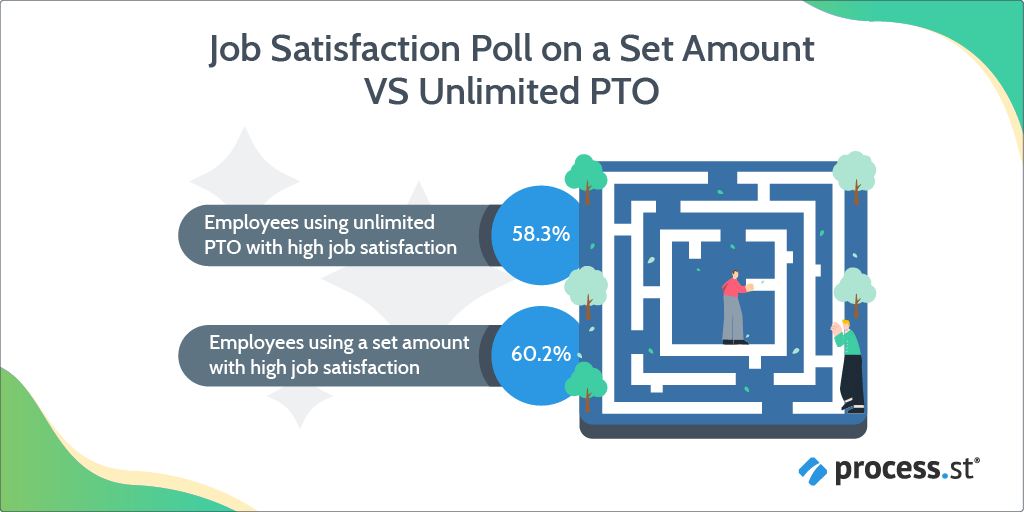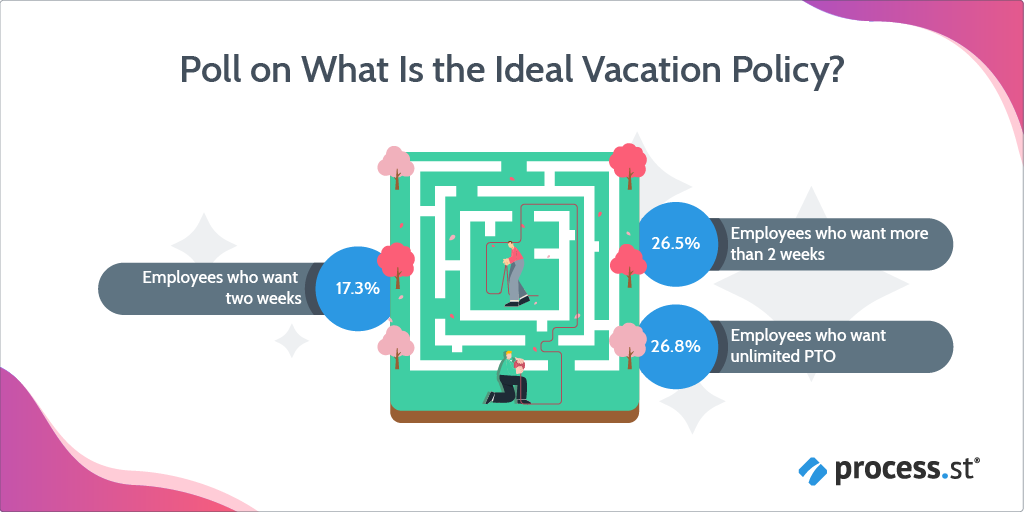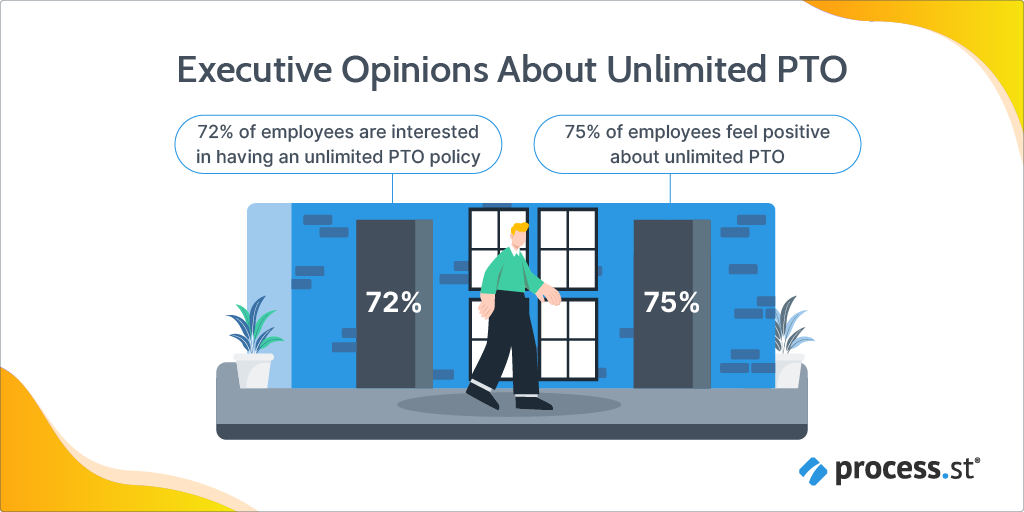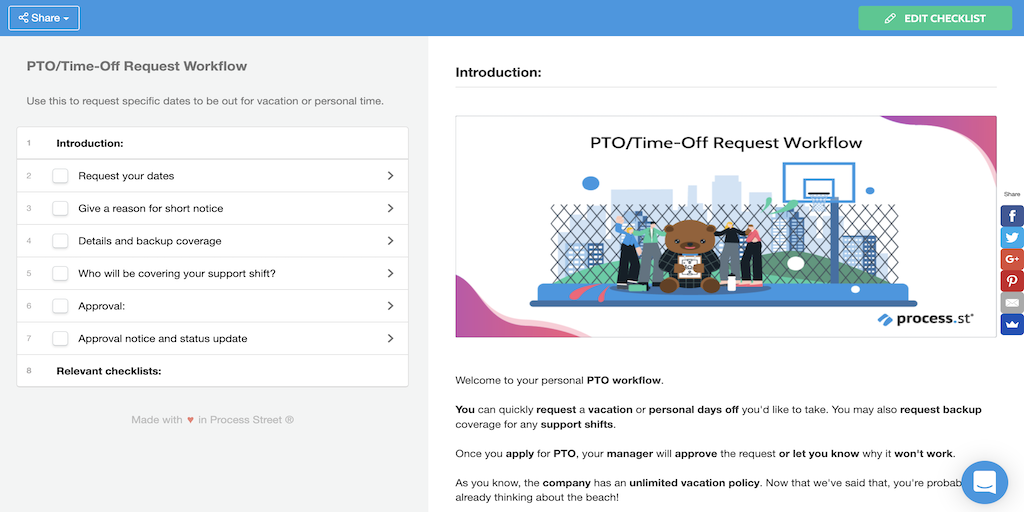
When I researched the unlimited PTO policy, I started thinking of a famous spy.
That’s because my eight-week paid time off was due to James Bond.
I realized that while I sat in a Shanghai bakery. Ten years earlier, I’d bought a set of James Bond books in a bric-a-brac store. Before coming to China, I’d sold the books and made a considerable profit.
I hadn’t intentionally taken an eight-week vacation, but I’ll explain that paradox at the end of the article.
Whether eight weeks or one week, PTO (paid time off) is essential. It increases:
Recently, unlimited PTO has exploded in popularity. This Process Street post will guide you through the drawbacks and benefits of this ever-popular policy. You can also use our new template on the subject with your free Process Street account.
Here are four key topics to help you understand and use an unlimited PTO policy:
- What is unlimited PTO?
- 3 Drawbacks of unlimited PTO
- 3 Benefits of unlimited PTO
- An unlimited PTO policy example
What is unlimited PTO?

Employees receive unlimited paid vacation time. The employees can also ask for this leave whenever they feel it is needed. This benefit is more well known to be offered by start-up and tech companies, but the policy is gaining ground in more and more workplaces.
Over four years, the number of job postings mentioning the policy increased by 178%. Some believe unlimited PTO is a marketing tool for recruiting talent instead of a serious policy. Talent acquisition recruiters are known to offer this perk to attract top-quality candidates.
Who offers unlimited PTO?
Tech companies, including Hubspot, offer unlimited paid time off. It’s also popular in start-ups due to the example set by companies such as Dropbox. In 2004, Netflix began offering the policy. As Netflix’s employee turnover is only 11% per year, you could argue that this employee benefit may be working for them. Other companies to offer unlimited PTO include:
However, unlimited PTO is still a thin-on-the-ground commodity. According to a survey by XpertHR, only 4% of 639 companies surveyed offer the fringe benefit. It’s a bonus that only 9% of workers enjoy.
“Don’t be afraid to change the model.”
– Reed Hastings, Founder and CEO of Netflix
Is unlimited PTO really unlimited?

Everything has limits. If every employee took five months off, it would be unworkable. For that reason, the policy has its foundations in trust. It works on the assumption that an employee won’t take advantage of it.
It would be relevant to mention the psychological contract. This unwritten pact is an agreement between the employee and the employer. It’s informal, but the CIPD (Chartered Institute of Personnel and Development) describes it as:
“How the parties themselves understand their relationship, their own views of commitment and what they can expect to receive in return.”
3 Drawbacks of unlimited PTO
Underused vacation can result in burnout
Employees sometimes fear taking leave, and unlimited PTO is intangible. Workers – especially those onboarding – want to be seen doing the right thing. Employees will follow suit if a culture of minimal vacation exists. A toxic corporate culture may be an accelerating factor in this issue, which is not good. The cost to companies in America is estimated to be $300 billion.
Not having enough time away from the workplace can result in:
See the TED video below for advice on how to reduce the costs of workplace stress:
Work-related stress affects attendance in the following way:
- 54% of employees miss 1 to 2 days per year due to stress
- 31% of employees miss 3 to 6 days per year due to stress
- 15% of employees miss more than 6 days per year due to stress
Americans are particularly at risk from work-related stress. US employees take less vacation time than any other advanced economy. 55% of Americans are not even using all their paid time off.
One possible way to ensure employees take leave is to consider circulating an announcement email. You could include a gentle reminder asking staff to book their vacation using a workflow management tool.
You can also create a mandatory leave policy stating that employees must take at least two weeks off per year. A good idea might be to have a fixed leave policy in a central online hub for operational knowledge. You could also use it to store policies and documents such as leaves of absence.
Too many absent coworkers

Stress can be a problem for employees who must take the slack when others take a vacation. Resentment can build between colleagues over the issue. With unlimited PTO, you may have one employee taking a lot of time off and an overworked employee covering for everyone. This problem will affect efficiency in the long run. With every policy is a risk of abuse.
If only one employee knows how to complete a specific job, the whole team can suffer when they take leave. That’s why documenting processes helps distribute equal knowledge across your team. A person who completes a task one day may not be the same who does that tomorrow. See our video below for an example:
Using online workflows, you can take a process and render it into a series of easy-to-follow tasks. The sooner you adopt this measure, the sooner you can cover employee absence effectively. You can ensure that when an employee who knows how to do a specific job takes leave, the whole team won’t suffer.
“Poor work design means that workflow stops when a particular employee is absent because no one can cover their tasks.”
– Joanna York, Why it’s so hard for US workers to ask for time off
PTO policy abuse
Unlimited PTO cannot be infinite. One solution to this issue is an unwritten rule regarding how many days off are acceptable. If you feel the limit is being taken advantage of, propose a meeting between the employee and human resources.
You might even consider an investigation process. A better way would be to offer transparency about the procedure. You could do this by letting staff know:
- They can access the full policy online
- Employees can request time off via an online workflow
- You can arrange meetings to discuss requests
You could use a knowledge base called Pages to keep the full policy online. Process Street created Pages – a free forever tool – to help you store your documents. Your documents can be made available anywhere and on any device. You can store documents including your:
3 Benefits of unlimited PTO

Increased employee engagement
By allowing employees the autonomy to decide on how much leave they will take, you are offering them a sense of ownership. The process will also build trust. Studies show that job satisfaction is generally higher when employees feel their employers trust them. As a result, employees don’t dread coming to work and taking more time off.
You will also be supporting a work-life balance that improves employee retention. Furthermore, you will decrease burnout and increase employee engagement. Employee communication needn’t suffer as a result of this process. Online workflow management is a practice that makes tasks collaborative and easier. Take a look at the video below to see for yourself:
Unlimited PTO boosts time management
The policy can boost time management as a reward system. Employees must be on top of their work to take more leave effectively. Therefore, they must make better use of their working hours, leading to better planning. Human resources will find this helpful when planning time off to cover the work of absent employees.
As an HR manager, you could also save time by setting up a system where employees can submit requests for their PTO. One way to do this is utilizing a BPM (business process management) tool. BPM is a way to optimize and automate your business processes. For example, by using an online workflow with built-in approvals, your employees can book their leave ahead of time.
Increased employee productivity & well-being
Unlimited PTO can increase productivity by offering employees autonomy.
If an employee is keeping their troubles to themselves and not using your EAP (employee assistance program), unlimited PTO can help. Your employees can take time out to recover and spend time with family and friends.
Vacations improve employee well-being in the following ways:
- Building psychological resilience
- Giving employees more energy and motivation
- Reducing the risk of heart disease
An unlimited PTO policy example

Even if paid time off is unlimited, it is unlikely you will grant time off every time an employee requests it. You will need a process to cope with many leave requests – particularly during holiday seasons. Using workflows to monitor recurring and sometimes complex processes like these can help you save time and money in the long term.
Most human resources departments will have a leave management system in place. Employees will still need a manager to approve their request for time off. Once approved, employees may take their leave. This process can be time-consuming. At Process Street, we created a workflow to optimize and speed up this process. To try it yourself, have a look at our PTO/Time-Off Request Workflow.
Using workflows is an easier way to monitor time off. BPM can significantly help if you are in a small HR team with fewer employees.
You can use software, like Process Street, to involve employees and their managers in a self-serve process. As Process Street is no-code software, employees find it easy to use. Managers can easily approve time-off quickly with a workflow app on their smartphone. As a result, HR saves office space by eliminating paperwork. You can do this using workflow software to replace paper daily checklists.
The free PTO template we’ve built for you to use with your free Process Street account will show you how effective this process is. Getting started with Process Street couldn’t be easier. Don’t waste time manually filling paper forms or unwieldy spreadsheets – use workflow management software to automate and streamline your unlimited PTO requests!
My unlimited vacation

I previously explained my eight-week vacation contained a paradox. I had to wait eight weeks for my employment visa. Consequently, my paid time off had its drawbacks and benefits:
Drawbacks
- Food and drink abuse: This was costly.
- I was traveling alone: Too many absent friends.
- Long vacations can result in boredom.
Benefits
- Free time to learn Japanese and how to teach English.
- Increased sleeping time.
- Unlimited time making new friends.
I organized my tasks into a daily workflow using process management to reduce drawbacks and increase benefits. You’ll probably notice I like to eat!
Morning:
✔️ Get a late breakfast
✔️ Read my book
✔️ Plan where to go
Midday:
✔️ Eat lunch
✔️ Return to hotel
✔️ Study Japanese
✔️ Learn how to teach English
Evening:
✔️ Meet new friends
✔️ Go for drinks
✔️ Visit a club
✔️ Smile and realize I’d repeat my tasks tomorrow
✔️ Sleep
Are you considering using unlimited PTO, or have you used it in the past? Please let us know your thoughts in the comments below!







 Workflows
Workflows Projects
Projects Data Sets
Data Sets Forms
Forms Pages
Pages Automations
Automations Analytics
Analytics Apps
Apps Integrations
Integrations
 Property management
Property management
 Human resources
Human resources
 Customer management
Customer management
 Information technology
Information technology



Mark Jones
Mark Jones is a content writer at Process Street.